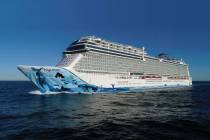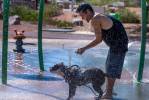Death Valley is full of life if you know where to look — PHOTOS
Gaze across some of the 3.4 million acres of Death Valley National Park and it's pretty obvious why a lost group of '49ers gave the valley its name — and why a mining-camp newspaper bragged, one April Fool's Day early in the 20th century, that the valley had "all the advantages of hell without the inconveniences." But if you know where to look, there's plenty of life in Death Valley.
While extreme heat and a corresponding lack of water usually are the biggest challenges in Death Valley, storms and the flash flooding that can result from them occasionally do a great deal of damage. Extensive flooding that resulted from a severe thunderstorm on Monday has closed a number of roads in the park, so before planning a trip, be sure to check the alerts on the park's website, www.nps.gov/deva, or call 760-786-3200. Badwater Road, as well as the side roads accessed from it, and Scotty's Castle Road and the side roads accessed from it are closed until further notice.
There are a number of ways to get to Death Valley. If you take Bell Vista Avenue/Bell Vista Road/State Line Road out of Pahrump to California Route 190 you'll pass through Amargosa Junction, site of the Amargosa Opera House, a cultural oasis where former New York dancer Marta Becket painted her walls to depict a 16th-century theater audience and for more than 40 years danced on the stage of the old Pacific Coast Borax Company social hall. The opera house isn't in the park, but it serves as an interesting introduction to Death Valley.
Farther along 190, shortly after entering the park, you'll pass the turnoff for Dante's View, which at 5,000 feet above the valley provides one of its most spectacular views. Via a short turnoff from 190 is Zabriskie Point, particularly popular at sunrise and sunset for its sweeping views of the eroded and colorful landscape. Also in the area is Twenty Mule Team Canyon, a short loop drive through, as the park puts it, "otherworldly badlands."
Continue along 190 and you'll pass the Furnace Creek Inn, which, its proprietors like to say, changed the valley "from hell hole to tourist mecca" when it opened in 1927. Built by Pacific Coast Borax in a doomed attempt to save its railroad, it was constructed of stucco, rock and terra cotta tile to better blend into the landscape. But amenities such as tennis courts, a spring-fed swimming pool and a courtyard with palms and fountains helped it earn a reputation as an oasis in the desert. Today, the four-diamond, 66-room inn has an elegant restaurant that's open for afternoon tea and Sunday brunch as well as breakfast, lunch and dinner.
Most of the life in Death Valley is clustered around the nearby Furnace Creek, which serves as a sort of village center for the park, home to educational, lodging, dining and even entertainment possibilities. The motel-style Furnace Creek Ranch is there, along with a small commercial strip that includes two restaurants and a bar.
The entire park is a good place to see wildlife, especially during cooler periods, but the Furnace Creek area tends to draw coyotes who like to hang around the stables and the clearings near the visitors center.
Another good place to see coyotes is the Furnace Creek Golf Course. Yes, a golf course in the middle of Death Valley, dotted with date palms and tamarisk trees. At 214 feet below sea level the 18-hole, par-70 course redesigned by Perry Dye in 1997 provides some interesting challenges for golfers. Those would include the fact that at this elevation (or lack thereof) drives don't go as far as expected, and that coyote puppies like to roll around on the course in the mornings, frequently taking off with a golf ball or two.
A good place to get oriented to the park's vastness is the National Park Service's Furnace Creek Visitors Center, currently on its winter schedule of 8 a.m. to 5 p.m. daily. Tell a ranger what your interests are, how much time you have and your vehicle's capabilities and he or she will provide maps and advice on what to see and how to get there. And your vehicle's capabilities are important, since some of the most interesting points in the park can be reached only via 4-wheel drive. But there are plenty of other points of interest that are much more accessible, on well-paved roads.
Close to the visitors center is the Harmony Borax Works, which processed ore in the early 1880s, producing three tons of borax daily. Getting the heavy borax to market — a 10-day trip to the railhead 165 miles away — presented a bit of a challenge, and thus were born the 20-mule teams. The borax works lasted only about five years and would no doubt have quickly slipped into obscurity had not Pacific Coast Borax (later U.S. Borax and Chemical Corporation), makers of 20 Mule Team Borax, sponsored the popular "Death Valley Days" on radio and TV from 1930 to 1975, bringing audiences true stories of the American West. Among the hosts of the anthology series were future President Ronald Reagan and prominent actors Robert Taylor and Dale Robertson.
Under normal conditions, a point that shouldn't be missed is Badwater Basin, south of Furnace Creek along Badwater Road, 200 square miles of salt flats at 279 feet below sea level, the lowest elevation in North America. As the name indicates there's usually water there as well, and yes, it's bad, because of the flats' concentration of minerals; Badwater Basin, legend has it, was named by a miner relieved that he finally had reached a source of water only to find his mule wouldn't drink it. The salt crust, with its hexagonal crystals, is extremely fragile, but a boardwalk provides viewing access.
Along Badwater Road are other points of interest, such as Natural Bridge (not as impressive as some of those in Utah, but still worth the short detour) and Artists Palette along Artists Drive, where the cliff rock is in myriad colors thanks to the various elements they contain. (Note that Artists Drive isn't open to vehicles longer than 25 feet).
The Keane Wonder Mine, which had been one of the most successful gold mines in Death Valley, is temporarily closed to the public. The mine, a honeycomb of spaces supported by pillars, has become extremely unstable and therefore dangerous, and leftover chemicals from the ore-extraction process could potentially expose visitors to elevated levels of lead and mercury.
There are numerous other points of interest in Death Valley, including Stovepipe Wells and Panamint Springs, but if time is limited — and if conditions are right — head north to the Scotty's Castle area. Monday's flooding damaged some of the infrastructure at the castle complex, so it's closed for the time being. Once it has re-opened, however, it will be well worth a stop.
Scotty's Castle Road, which runs to the area from Furnace Creek, is paved and usually good. Once you reach the castle area you can head slightly east to the Uberhebe Crater, where a massive volcanic eruption more than 300 years ago left the depression that's 600 feet deep.
But try not to miss Scotty's Castle. Built by a wealthy engineer in the '20s and '30s in the comparatively lush Grapevine Canyon, it's a richly decorated house (though not a castle) that, with the aid of the park's costumed interpreters, provides a peek into life in the valley as the Roaring Twenties headed into the Great Depression. And no, the owner/builder of the house wasn't named Scott, but Albert Mussey Johnson; the popular name came from a local miner/cowboy/raconteur named Walter Scott, or Death Valley Scotty, who liked to tell people it was his house — and Johnson, amused and apparently very tolerant, went along with the charade. The garden, with flowing stream, and Scotty's burial site on a nearby hilltop also are worth seeing.
— Contact Heidi Knapp Rinella at hrinella@reviewjournal.com. Find more of her stories at www.reviewjournal.com and follow @HKRinella on Twitter.









































